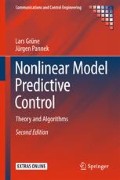Abstract
This chapter is particularly devoted to sampled data systems, which need to be discretized in order to be able to solve the optimal control problem within the NMPC algorithm numerically. We present suitable methods, discuss the convergence theory for one step methods and give an introduction into step size control algorithms. Furthermore,we explain how these methods can be integrated into NMPC algorithms, investigate how the numerical errors affect the stability of the NMPC controller derived from the numerical model and show which kind of robustness is needed in order to ensure a practical kind of stability.
Access this chapter
Tax calculation will be finalised at checkout
Purchases are for personal use only
References
Braess, D.: Finite Elements, 3rd edn. Cambridge University Press, Cambridge (2007) (Theory, fast solvers, and applications in elasticity theory. Translated from the German by Larry L. Schumaker)
Deuflhard, P., Bornemann, F.: Scientific Computing with Ordinary Differential Equations. Texts in Applied Mathematics, vol. 42. Springer, New York (2002) (Translated from the1994 German original by Werner C. Rheinboldt)
Grüne, L.: Asymptotic Behavior of Dynamical and Control Systems under Perturbation and Discretization. Lecture Notes in Mathematics, vol. 1783. Springer, Berlin (2002)
Grüne, L., Nešić, D.: Optimization based stabilization of sampled-data nonlinear systems via their approximate discrete-time models. SIAM J. Control Optim. 42, 98–122 (2003)
Gyurkovics, E., Elaiw, A.M.: Stabilization of sampled-data nonlinear systems by receding horizon control via discrete-time approximations. Automatica 40(12), 2017–2028 (2004)
Gyurkovics, E., Elaiw, A.M.: Conditions for MPC based stabilization of sampled-data nonlinear systems via discrete-time approximations. In: Findeisen, R., Allgöwer, F., Biegler, L.T. (eds.) Assessment and Future Directions of Nonlinear Model Predictive Control. Lecture Notes in Control and Information Sciences, vol. 358, pp. 35–48. Springer, Berlin (2007)
Hairer, E., Wanner, G.: Solving Ordinary Differential Equations. II, Springer Series in Computational Mathematics, vol. 14, 2nd edn. Springer, Berlin (1996)
Hairer, E., Nørsett, S.P., Wanner, G.: Solving Ordinary Differential Equations. I, 2nd edn. Springer Series in Computational Mathematics, vol. 8, 2nd edn. Springer, Berlin (1993)
LeVeque, R.J.: Finite Difference Methods for Ordinary and Partial Differential Equations. SIAM, Philadelphia (2007)
Nešić, D., Teel, A.R.: A framework for stabilization of nonlinear sampled-data systems based on their approximate discrete-time models. IEEE Trans. Automat. Control 49(7), 1103–1122 (2004)
Stoer, J., Bulirsch, R.: Introduction to Numerical Analysis. Texts in Applied Mathematics, vol. 12, 3rd edn. Springer, New York (2002) (Translated from the German by R. Bartels, W. Gautschi and C. Witzgall)
Tröltzsch, F.: Optimal Control of Partial Differential Equations. Graduate Studies in Mathematics, vol. 112. American Mathematical Society, Providence (2010) (Theory, methods and applications. Translated from the 2005 German original by Jürgen Sprekels)
Author information
Authors and Affiliations
Corresponding author
Problems
Problems
-
1.
Prove that the solution \(\varphi (t,0,x_0,u)\) of (2.6) with \(t\in [0,T]\) and constant control function u satisfies the integral equation
$$\begin{aligned} \varphi (\tau _{i + 1}; \tau _0, x_0, u) = \varphi (\tau _i; \tau _0, x_0, u) + \int \limits _{\tau _i}^{\tau _{i + 1}} f_c( \varphi (t; \tau _0, x_0, u), u ) dt. \end{aligned}$$for all \(\tau _{i},\tau _{i+1}\in [0,T]\) with \(\tau _{i+1}> \tau _i\).
-
2.
Prove that the Euler and the Heun scheme satisfy the Lipschitz condition (11.5) if the vector field \(f_c\) satisfies the Lipschitz condition from Assumption 2.4.
-
3.
Given the control system \(\dot{x}(t) = x(t) + u(t)\) with stage cost \(\ell (x, u) = x^2 + u^2\).
-
(a)
Consider the NMPC Algorithm 3.1 with \(N = 2\) and f generated by the Euler method with \(\mathscr {G}= \mathscr {T}\) for (11.14) and (11.15). Prove that the control \(\mu _N(x)\) converges tends to zero as \(T \rightarrow 0\) for each \(x\in \mathbb {R}\).
-
(b)
Consider the same situation as in (a) but with the grid
$$\begin{aligned} \mathscr {G}:= \{ \tau _i = i {T}/{k}\,|\, i = 0,\ldots ,Nk \} \end{aligned}$$with \(k\in \mathbb {N}\). Does the control value \(\mu _N(x)\) converge if \(T>0\) is fixed and k tends to infinity?
-
(a)
-
4.
Consider the differential equation
$$\begin{aligned} \dot{x}_1(t)&= -x_2(t) \\ \dot{x}_2(t)&= {-}x_1(t) \end{aligned}$$whose solution shall be used to generate a time varying reference for an NMPC algorithm.
-
(a)
Using a transformation to polar coordinates, compute the analytical solution of the system.
-
(b)
Show that the numerical solution of the system using Euler’s method will deviate from the analytical solution from (a) for every step size \(h > 0\) and every initial value \(x_0 \not = (0, 0)^\top \).
-
(c)
Applying the transformation to polar coordinates, show that the occurring error from (b) can be avoided if the resulting differential equation is solved using Euler’s method.
-
(a)
-
5.
Consider the continuous time control system
$$\begin{aligned} \dot{x}_1(t)&= -x_2(t) + v(t) \\ \dot{x}_2(t)&= {-}x_1(t) \end{aligned}$$where u shall be computed via NMPC to track the (exact) time varying reference solution from Problem 4.
-
(a)
Show that this system is (uniformly) asymptotically controllable in the sense of Definition 4.2 for control functions which are piecewise constant on each interval \([iT,(i+1)T)\) for arbitrary sampling time \(T > 0\).
-
(b)
Consider the approximate discrete time system (11.12) with \(\tilde{\varphi }\) obtained from applying the Euler method with step size \(h=T/k\) for arbitrary \(k\in \mathbb {N}\) to the (non transformed) differential equation. Show that this approximate system is not asymptotically controllable regardless how \(T>0\) and \(k\in \mathbb {N}\) are chosen.
Hint for (b): A necessary condition for asymptotic controllability is that the reference is a solution of the system.
-
(a)
Rights and permissions
Copyright information
© 2017 Springer International Publishing Switzerland
About this chapter
Cite this chapter
Grüne, L., Pannek, J. (2017). Numerical Discretization. In: Nonlinear Model Predictive Control. Communications and Control Engineering. Springer, Cham. https://doi.org/10.1007/978-3-319-46024-6_11
Download citation
DOI: https://doi.org/10.1007/978-3-319-46024-6_11
Published:
Publisher Name: Springer, Cham
Print ISBN: 978-3-319-46023-9
Online ISBN: 978-3-319-46024-6
eBook Packages: EngineeringEngineering (R0)

